ghost town
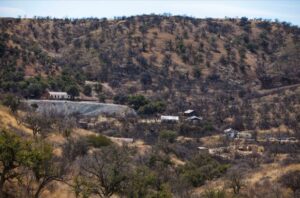
 Lots of mining towns started out when someone discovered gold, silver, or some other precious metal. A few of them have continued to produce enough “treasure” to maintain and even rapidly grow a town. Others fizzled in a short time, or even a long time, but when the mines dried up, the towns went with them. Because of that, there are numerous ghost towns that dot the United States…and probably other nations too.
Lots of mining towns started out when someone discovered gold, silver, or some other precious metal. A few of them have continued to produce enough “treasure” to maintain and even rapidly grow a town. Others fizzled in a short time, or even a long time, but when the mines dried up, the towns went with them. Because of that, there are numerous ghost towns that dot the United States…and probably other nations too.
Ruby, Arizona is a ghost town in very near the Arizona-Mexico border. It is one of the best-preserved ghost towns in the state. In the 1700s, rich minerals were discovered there by the Spaniards, but they were not rich enough for their tastes, so only a limited amount of placer mining occurred before they moved on, leaving the area largely undisturbed for nearly a century, until two mining engineers, Chares Poston and Henry Ehrenberg, 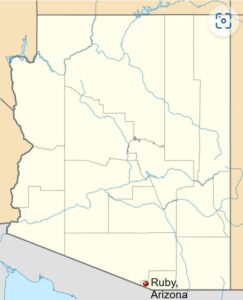 revived the old Spanish placers in Montana Gulch in 1854. With the discovery of rich veins of gold and silver, which the Spaniards had somehow missed, came other prospectors looking for their own rich strike. While the area was rich in gold and silver, it also had Apache Indians, and they were…hostile, to say the least.
revived the old Spanish placers in Montana Gulch in 1854. With the discovery of rich veins of gold and silver, which the Spaniards had somehow missed, came other prospectors looking for their own rich strike. While the area was rich in gold and silver, it also had Apache Indians, and they were…hostile, to say the least.
Nevertheless, mining did proceed starting around 1877. Ruby, Arizona was founded as a mining town in Bear Valley, originally named Montana Camp. It was so named because the miners were mining at the foot of Montana Peak. The Montana mine produced gold, silver, lead, zinc, and copper…peaking in the mid-1930s. While never a large town, Ruby had a population of about 1,200 people. The post office was established on April 11, 1912, by the mining camp’s general store, Julius Andrews. When Andrews named the post office “Ruby,” after his wife, Lille B Ruby Andrews, and the mining camp became known as Ruby. The post office closed on May 31, 1941.
The town of Ruby has been through some wild times, and never was that more evident than the years between 1920 and 1922, when the town and the area surrounding Ruby was the scene of three double homicides known as the Ruby Murders. The largest manhunt in the history of the Southwest followed the crimes, and it included the first airplane ever used in an Arizona manhunt. The town’s most prosperous period was in the late 1920s 
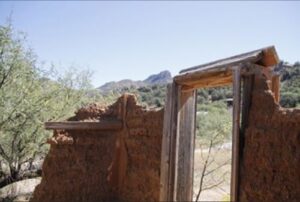 and 1930s, when the Eagle-Picher Mining Company operated the mine. They also upgraded the camp. The Montana mine was the leading lead and zinc producer in Arizona from 1934 to 1937. In 1936, it was third in silver production. Nevertheless, it seems, in mining anyway, that “all good things must come to an end” and so it was with the mine, which closed in 1940. By the end of 1941 Ruby was abandoned.
and 1930s, when the Eagle-Picher Mining Company operated the mine. They also upgraded the camp. The Montana mine was the leading lead and zinc producer in Arizona from 1934 to 1937. In 1936, it was third in silver production. Nevertheless, it seems, in mining anyway, that “all good things must come to an end” and so it was with the mine, which closed in 1940. By the end of 1941 Ruby was abandoned.
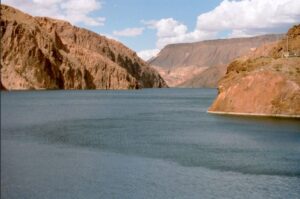
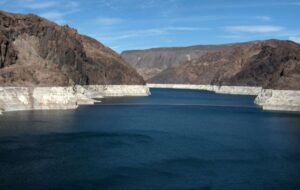 As a kid, I remember going to the Grand Canyon, Las Vegas, and Lake Mead. I particularly enjoyed Lake Mead, because the water was warm, unlike most lakes. At the time, and for many years afterward, I really didn’t know much about the lake, its origins, or its secrets. These days, I maybe know too much about its secrets. In fact, some of them are really creepy. Many lakes sport hidden ghost towns, underground ranches, and various sunken boats. There are probably more bodies in them that we know or want to think about too, but when a drought occurs and we find ourselves hearing about body after body being found in a lake that is close to one of the big mob-controlled areas of the nation, it makes you wonder exactly what happened here and just how many more bodies will surface. Well, in the case of Lake Mead, the answer is a total of five bodies…so far. Who knows how many more will surface.
As a kid, I remember going to the Grand Canyon, Las Vegas, and Lake Mead. I particularly enjoyed Lake Mead, because the water was warm, unlike most lakes. At the time, and for many years afterward, I really didn’t know much about the lake, its origins, or its secrets. These days, I maybe know too much about its secrets. In fact, some of them are really creepy. Many lakes sport hidden ghost towns, underground ranches, and various sunken boats. There are probably more bodies in them that we know or want to think about too, but when a drought occurs and we find ourselves hearing about body after body being found in a lake that is close to one of the big mob-controlled areas of the nation, it makes you wonder exactly what happened here and just how many more bodies will surface. Well, in the case of Lake Mead, the answer is a total of five bodies…so far. Who knows how many more will surface.
One body was found in a barrel, with a gun nearby, causing speculation of a mob killing, and possibly making people who might have been the perpetrators of mob murders…if they are still alive, to become a little nervous about their crimes being found out. Of course, the police aren’t telling us much, but it is said that the body in the barrel, discovered in May, had been shot in the head and after being stuffed in the barrel it was thrown overboard, in the hope that it would never be seen again. It was the type of killing that was classic mob style, or so we’ve been told in the movies. Las Vegas was, and maybe still is, a big mob crime city, and this type of killing was a trademark in the 1970s and 19802. So, it is entirely possible that the killer is still alive and could be brought to justice.
Shortly after the body in the barrel was found, another body surfaced, and then in July a third body was found. Days after the body in the barrel surfaced, another corpse was reported. A third was discovered in July. Now, the skeletal remains of two more people were found just this month in the Swim Beach area. It makes me 
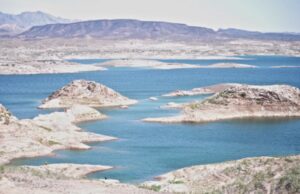 wonder how many more bodies will surface, if the drought continues and the lake level continues to drop. The lake level has dropped nearly 200 feet due to two decades of drought. Right now, the lake is very close to the level it was when it was originally filled after the building of Hoover Dam. I guess the old saying about the truth finding you out is true. the bodies, some long hidden, are coming out to tell of their demise.
wonder how many more bodies will surface, if the drought continues and the lake level continues to drop. The lake level has dropped nearly 200 feet due to two decades of drought. Right now, the lake is very close to the level it was when it was originally filled after the building of Hoover Dam. I guess the old saying about the truth finding you out is true. the bodies, some long hidden, are coming out to tell of their demise.
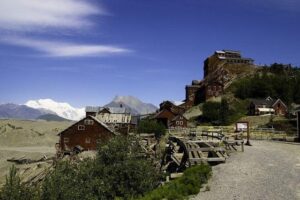 When the minerals in a mine run out, or become less valuable, the mine tends to close down. These days, they try to return the mine to it’s prior state, but then many mines these days are pit mines, or strip mines. I suppose it is easier to return them to their prior state when you only have to fill in the hole, and I’m not opposed to that process. It can make a beautiful place out of ground that has been ripped apart. In some cases, it looks better after the reclamation.
When the minerals in a mine run out, or become less valuable, the mine tends to close down. These days, they try to return the mine to it’s prior state, but then many mines these days are pit mines, or strip mines. I suppose it is easier to return them to their prior state when you only have to fill in the hole, and I’m not opposed to that process. It can make a beautiful place out of ground that has been ripped apart. In some cases, it looks better after the reclamation.
The Kennecott Mine, often spelled Kennicott, is an abandoned mining camp in the Valdez-Cordova Census Area, which is now the Copper River Census Area in the state of Alaska. The mine was, at one time, the center of activity for several copper mines. Kennecott Mines was named after the Kennicott Glacier in the valley below. The geologist Oscar Rohn named the glacier after Robert Kennicott during the 1899 US Army Abercrombie Survey. A “clerical error” resulted in the substitution of an “e” for the “i,” supposedly by Stephen Birch himself. The mine is located northeast of Valdez, inside Wrangell-Saint Elias National Park and Preserve. The camp and mines are now a National Historic Landmark District administered by the National Park Service. It was declared a National Historic Landmark in 1986. It’s status as a historical site, probably explains the good shape it is in. Many historical sites deteriorate badly before anyone realizes that they should be preserved as a part of history.
Two prospectors, “Tarantula” Jack Smith and Clarence L Warner, who were with a group of prospectors associated with the McClellan party in the summer of 1900, spotted “a green patch far above them in an  improbable location for a grass-green meadow.” Upon inspection, the green turned out to be malachite, located with chalcocite…aka “copper glance,” and the location of the Bonanza claim. A few days later, Arthur Coe Spencer, US Geological Survey geologist also found chalcocite at the same location. It was the birth of a copper mine.
improbable location for a grass-green meadow.” Upon inspection, the green turned out to be malachite, located with chalcocite…aka “copper glance,” and the location of the Bonanza claim. A few days later, Arthur Coe Spencer, US Geological Survey geologist also found chalcocite at the same location. It was the birth of a copper mine.
A mining engineer just out of school, named Stephen Birch was in Alaska looking for investment opportunities in minerals. He was young, but he came with the financial backing of the Havemeyer Family and another investor named James Ralph, from his days in New York. Birch spent the winter of 1901-1902 acquiring the “McClellan group’s interests” for the Alaska Copper Company of Birch, Havemeyer, Ralph and Schultz, later to become the Alaska Copper and Coal Company. He spent the summer of 1901, visiting the property and “spent months mapping and sampling.” He confirmed the Bonanza mine and surrounding deposits, were at the time, the richest known concentration of copper in the world.
Kennecott had five mines: Bonanza, Jumbo, Mother Lode, Erie, and Glacier. “Glacier, which is really an ore extension of the Bonanza, was an open-pit mine and was only mined during the summer. Bonanza and Jumbo were on Bonanza Ridge about 3 miles from Kennecott. The Mother Lode mine was located on the east side of the ridge from Kennecott. The Bonanza, Jumbo, Mother Lode and Erie mines were connected by tunnels. The Erie mine was perched on the northwest end of Bonanza Ridge overlooking Root Glacier about 3.7 miles up a glacial trail from Kennecott.” The copper ore was transported to Kennecott by way of the trams which head-ended at Bonanza and Jumbo. From Kennecott the ore was hauled mostly in 140-pound sacks on steel flat cars  to Cordova, 196 rail miles away on the Copper River and Northwestern Railway (CRNW).
to Cordova, 196 rail miles away on the Copper River and Northwestern Railway (CRNW).
In 1925 a Kennecott geologist predicted that the end of the high-grade ore bodies was in sight. The mines days were numbered. The highest grades of ore were largely depleted by the early 1930s. The Glacier Mine closed in 1929, and the rest followed soon after. The last train left Kennecott on November 10, 1938. It was now a ghost town. Over a period of 20 years the population dropped from 494 in 1920 to 5 in 1940. Thankfully the historical value of this particular site was not lost, and is still there today.
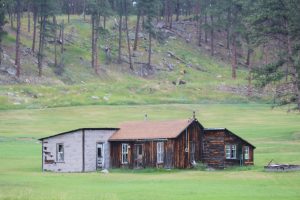 When we think of “ghost towns,” we think of abandoned mining camps, towns that were passed by when railroads or highways went through, and these days, New York City. There are many ways for a town or even a city to die out…most of them are really sad. Sometimes, a town just outlives its usefulness, as was the case during the gold rush. When the gold ran out, the miners moved on or went back east to their homes there. The little town that had provided the supplies, homes, entertainment, and necessary offices, like post office and land offices, is simply not needed anymore. I’m sure that the people of the town held out as long as it made sense, and then they picked up and moved on to some other place that needed things like a general store for supplies. The little town then sat there and slowly slipped into disrepair and decay. When we visit such towns, we see history unfolding before us, and we are usually excited to find such an amazing relic. We can’t wait to explore.
When we think of “ghost towns,” we think of abandoned mining camps, towns that were passed by when railroads or highways went through, and these days, New York City. There are many ways for a town or even a city to die out…most of them are really sad. Sometimes, a town just outlives its usefulness, as was the case during the gold rush. When the gold ran out, the miners moved on or went back east to their homes there. The little town that had provided the supplies, homes, entertainment, and necessary offices, like post office and land offices, is simply not needed anymore. I’m sure that the people of the town held out as long as it made sense, and then they picked up and moved on to some other place that needed things like a general store for supplies. The little town then sat there and slowly slipped into disrepair and decay. When we visit such towns, we see history unfolding before us, and we are usually excited to find such an amazing relic. We can’t wait to explore.
Sometimes, as in the case of New York City, a city is “shut down” to help those within it to recover from something, such as a pandemic. That doesn’t usually happen when a new virus goes through, but it did with 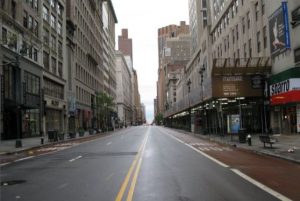 Covid-19. Normally, only the sick people are quarantined, but in this case, the medical experts (and many people would say that I’m using that term loosely), decided to quarantine the well people in the hope of stopping the spread of Covid-19. I can’t say whether that has been a good or a bad thing, but I tend to think it was a bad thing. When a city like New York City, suddenly is completely empty, businesses are shut down, jobs lost, and it didn’t seem to help. Months later, the city is still, for the most part, shut down, and businesses are considering a move to another location, just like the ghost towns of the old west when the mines dried up. The shut down of our cities is a slippery slope, and one that I think needs to be avoided, at all costs. Still, man will tell you that I’m not an expert, and they would be right. I am just a person who sees that our country cannot continue with this shut down much longer. Something has to change…something!!
Covid-19. Normally, only the sick people are quarantined, but in this case, the medical experts (and many people would say that I’m using that term loosely), decided to quarantine the well people in the hope of stopping the spread of Covid-19. I can’t say whether that has been a good or a bad thing, but I tend to think it was a bad thing. When a city like New York City, suddenly is completely empty, businesses are shut down, jobs lost, and it didn’t seem to help. Months later, the city is still, for the most part, shut down, and businesses are considering a move to another location, just like the ghost towns of the old west when the mines dried up. The shut down of our cities is a slippery slope, and one that I think needs to be avoided, at all costs. Still, man will tell you that I’m not an expert, and they would be right. I am just a person who sees that our country cannot continue with this shut down much longer. Something has to change…something!!
While we like to visit ghost towns, we often don’t realize the hardship and heartache that went into turning these places into ghost towns. Just like we have seen in the cities across America, the business shutting down  means the loss of a livelihood for millions of people. Depression sets in, and eventually everyone is angry about their rights being stepped on…and it’s not just one group, it’s many. Then, the sad thing is that there emerges a group of people who are…left out. The ones who don’t fit into any of the protesting groups…they are the quiet majority…the ones who usually just go quietly about their daily lives, without hurting anyone. Sadly these are the overlooked ones, and usually the last ones to leave the ghost town, because they are the ones who try to hope for the future. These days, that is much of America. We are just hanging out, waiting for things to get better, so we can get back to normal. Here’s to normal.
means the loss of a livelihood for millions of people. Depression sets in, and eventually everyone is angry about their rights being stepped on…and it’s not just one group, it’s many. Then, the sad thing is that there emerges a group of people who are…left out. The ones who don’t fit into any of the protesting groups…they are the quiet majority…the ones who usually just go quietly about their daily lives, without hurting anyone. Sadly these are the overlooked ones, and usually the last ones to leave the ghost town, because they are the ones who try to hope for the future. These days, that is much of America. We are just hanging out, waiting for things to get better, so we can get back to normal. Here’s to normal.
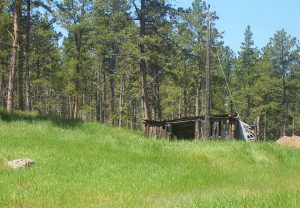 “Every state has ghost towns. Eastern and Midwestern States are no exception. At one time or another you may have driven your car right by a ghost town, not aware of it. If you are a hiker, backpacker, or a hunter, you may have walked past or through a ghost town not knowing one was there.” I read that statement on a web site I was using to research stories for my blog. I had read many stories about ghost towns, but this one intrigued me. My husband, Bob Schulenberg and I have hiked many of the trails in the Black Hills, and I can’t even begin to count the number of times we have walked past old abandoned, crumbling, falling down buildings. To us, they seemed like just an abandoned farmhouse and out buildings, but now I am beginning to wonder if we have been one of those hikers who have walked right through a ghost town, and didn’t even know it. In fact, I’ll bet we have walked right through many a ghost town during our many hikes.
“Every state has ghost towns. Eastern and Midwestern States are no exception. At one time or another you may have driven your car right by a ghost town, not aware of it. If you are a hiker, backpacker, or a hunter, you may have walked past or through a ghost town not knowing one was there.” I read that statement on a web site I was using to research stories for my blog. I had read many stories about ghost towns, but this one intrigued me. My husband, Bob Schulenberg and I have hiked many of the trails in the Black Hills, and I can’t even begin to count the number of times we have walked past old abandoned, crumbling, falling down buildings. To us, they seemed like just an abandoned farmhouse and out buildings, but now I am beginning to wonder if we have been one of those hikers who have walked right through a ghost town, and didn’t even know it. In fact, I’ll bet we have walked right through many a ghost town during our many hikes.
I love photographing old buildings, and often find myself wondering how long they had been there, and why 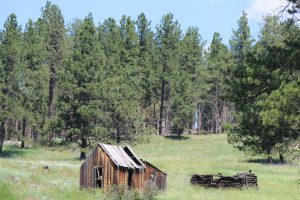 they were left to rot. Of course, the Black Hills is rich in gold rush history, so a ghost town or tow makes perfect sense. We have driven through, and by some of them, and even passed through some while riding he 1880 Train, but for some reason, it didn’t occur to me that some of the old buildings we have hiked by could have been part of a ghost town, but looking back now, it makes perfect sense. I have often found myself wondering who lived there and what their lives might have been like back when the house was newly built. Still, it didn’t occur to me that it might be part of a ghost town. I guess that is because I always thought that all the ghost towns would be well documented with signs alerting the tourists to the site. In reality, those signs would be placed by the town’s owner, who was trying to make a buck by romanticizing the site…and that’s ok too, but that doesn’t mean that every ghost town was so well documented. In reality, it’s the ghost towns that are less documented that hold the most intrigue, because much less is known about them.
they were left to rot. Of course, the Black Hills is rich in gold rush history, so a ghost town or tow makes perfect sense. We have driven through, and by some of them, and even passed through some while riding he 1880 Train, but for some reason, it didn’t occur to me that some of the old buildings we have hiked by could have been part of a ghost town, but looking back now, it makes perfect sense. I have often found myself wondering who lived there and what their lives might have been like back when the house was newly built. Still, it didn’t occur to me that it might be part of a ghost town. I guess that is because I always thought that all the ghost towns would be well documented with signs alerting the tourists to the site. In reality, those signs would be placed by the town’s owner, who was trying to make a buck by romanticizing the site…and that’s ok too, but that doesn’t mean that every ghost town was so well documented. In reality, it’s the ghost towns that are less documented that hold the most intrigue, because much less is known about them.
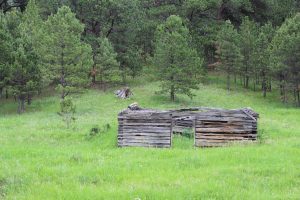 I think that the next time we hike and find ourselves passing by an old rotting building, that I will feel much different about the place than I did in the past. I think I will still wonder about who lived there, but also about whether or not it was a ghost town that once sprung up, and prospered, only to be choked out when hard times hit and the people who lived there moved on in search of a better life. That was, after all, the fate of every ghost town. It was a town that sprung up with the promise of becoming a bustling city, but it was in the wrong place, and life could not be sustained there, so eventually it withered and died off, leaving only the buildings to tell of its presence, and then only to those who happened to pass by.
I think that the next time we hike and find ourselves passing by an old rotting building, that I will feel much different about the place than I did in the past. I think I will still wonder about who lived there, but also about whether or not it was a ghost town that once sprung up, and prospered, only to be choked out when hard times hit and the people who lived there moved on in search of a better life. That was, after all, the fate of every ghost town. It was a town that sprung up with the promise of becoming a bustling city, but it was in the wrong place, and life could not be sustained there, so eventually it withered and died off, leaving only the buildings to tell of its presence, and then only to those who happened to pass by.

